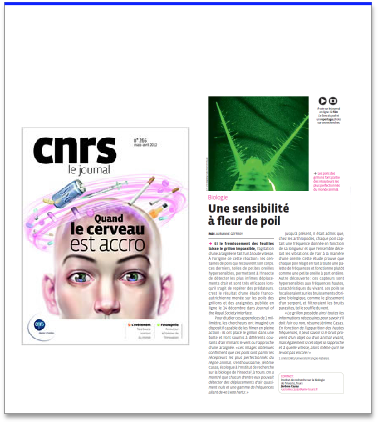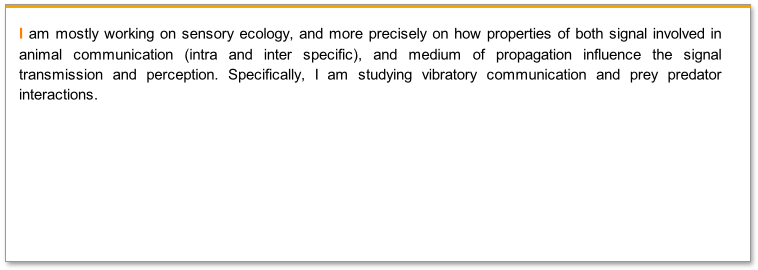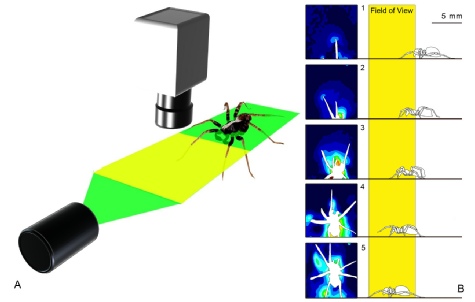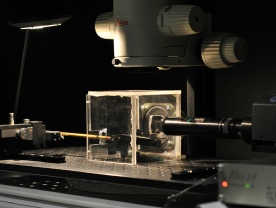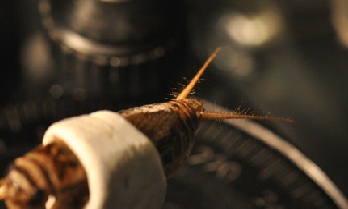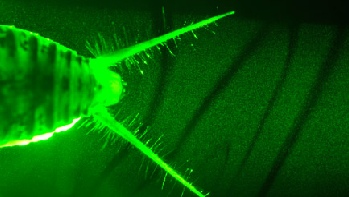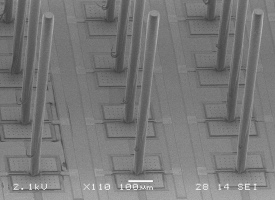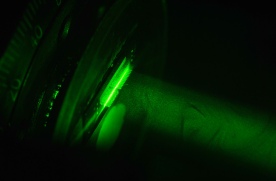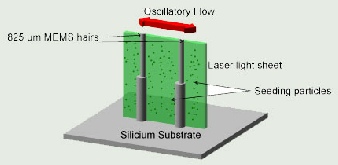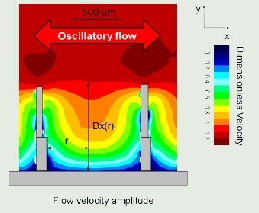Publication/ Talks :
Casas J & Steinmann T (2014) Flow disturbances during attack explain variation in predator foraging modes. (In revision for Proceedings of the Royal Society B)
G.J.M Krijnen, H. Droogendijk, T. Steinmann, A.M.K. Dagamseh, R.K. Jaganatharaja and J. Casas (2014) Hair-based ow-sensing inspired by the cricket cercal system, Handbook of Biomimetics and Bioinspiration
T. Steinmann & J. Casas (2013). Laser-based methods for analyzing fluid flow sensing by organisms. In Flow sensing in air and water, H. Bleckmann & J. Mogdans. Springer Verlag.
F. Dupuy, T. Steinmann, D. Pierre, JP. Christidès, G. Cummins, C. Lazzari, J. Miller, and J. Casas (2012) Responses of cricket cercal interneurons to realistic naturalistic stimuli in the field, Journal of Experimental Biology, in press
E L Morley, T Steinmann, J Casas, and D Robert (2012) Directional cues in Drosophila melanogaster audition: structure of acoustic flow and inter-antennal velocity differences, Journal of Experimental Biology, in press
T Steinmann and J Casas (2011) Impact of the aerodynamical signature of attacking spiders on the sensory performance of prey, Flow sensing in air and water, 18-21 July 2011, Bonn, Germany
T Steinmann and J Casas (2011) Impact of the aerodynamical signature of attacking spiders on the sensory performance of prey, International Workshop on bio inspired robots, 6-8 April 2011, Nantes, France
B Bathellier, T Steinmann, F G. Barth and J Casas (2011) Air motion sensing hairs of arthropods detect high frequencies at near-maximal mechanical efficiency. J. R. Soc. Interface (online) doi: 10.1098/rsif.2011.0690
Casas J, Steinmann T, and Krijnen G (2010) Why do insects have such a high density of flow-sensing sensors hairs? Insights from the hydromechanics of biomimetic MEMS. J. R. Soc. Interface 7, 1487-1495. doi: 10.1098/rsif.2010.0093
Steinmann T., Casas J. (2008) Viscous coupling between mechanosensing hairs, Invertebrate sound and vibration Meeting, 2008 Tours, France
Casas J, Steinmann T, Dangles O (2008). The Aerodynamic Signature of Running Spiders. Plos ONE. 3(5): e2116. doi:10.1371/journal.pone.0002116.
Dangles O, Steinmann T, Pierre D, Vannier F, Casas J (2008). Relative contributions of organ shape and receptor arrangement to the design of cricket's cercal system. Journal of Comparative Physiology A. In Press.
Steinmann T, Casas J, Krijnen G, Dangles O (2006). Air-flow sensitive hairs: boundary layers in oscillatory flows around arthropod appendages. Journal of Experimental Biology 209: 4398-4408.
Dangles O, Ory N, Steinmann T, Christides JP, Casas J (2006). Spider's attack vs. cricket's escape: velocity
We have visualized the flow around single MEMS sensors and the canopy effects with
many sensors Single and tandem MEMS hairs of varying interhair distances were subjected
to oscillatory flows of varying frequency.
Decreasing hair-to-hair distance markedly reduced flow velocity amplitude and increased
the phase shift between the far-field flow and the flow between hairs.
These effects were stronger for lower flow frequencies. We predict strong hydrodynamic
coupling within whole natural hair canopies exposed to natural stimuli, depending
on arthropod and hair sizes, and hair density.
Thus, rather than asking why arthropods have so many hairs, it may be useful to address
why hairs are packed together at such high densities, particularly given the exquisite
sensitivity of a single hair.












